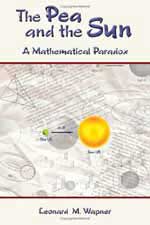'The pea and the sun'

The Pea and the sun: a mathematical paradox
by Leonard M. Wapner
The topic of this book - the Banach-Tarski Paradox - is a result so strange and counterintuitive that the author says he didn't believe it when he first saw it. The "paradox" - in fact an impeccable mathematical theorem - says that a small sphere, for example a pea, can be cut into as few as five pieces which can then be reassembled so as to make a far bigger sphere, for example the sun.
The result seems to suggest that mathematicians have discovered what alchemists never did: a way to make something out of nothing. In fact, the secret lies in the strange dissection used - the "pea" is cut into five pieces according to a method that could never in real life be implemented. The pieces are so-called "non-measurable" sets, which means just what it sounds like: sets that cannot be assigned any size (or "measure") at all without causing contradiction. By their nature, non-measurable sets cannot be constructed via explicit geometric steps, and, as the author says: "Some might find it disagreeable that such sets exist, but that is mathematics!"
The author gives a fascinating account, in a journalistic style, of the history of the Banach-Tarski Theorem, devoting a chapter to the cast of characters, including Georg Cantor, Kurt Gödel, Paul Cohen, and of course Stefan Banach and Alfred Tarski. Chapter 3, on the different sorts of paradoxes, is particularly entertaining. Some of the paradoxes described are fallacies where the error is hard to spot, but others, like the Banach-Tarski paradox and many other counterintuitive results that arise from the seemingly innocuous "Axiom of choice", are correct but seem absurd. I particularly liked "Hotel Infinity", a song written by Lawrence M. Lesser that is reproduced in full here, which sets Hilbert's "Hotel Paradox" to the tune of "Hotel California"!
Wapner quotes Mark Twain as saying: "Truth is stranger than fiction, but it is because fiction is obliged to stick to possibilities; truth isn't," and it is certainly true that the development of this area of mathematics - measure theory - has been a tale of astonishment and disbelief. Georg Cantor, who proved many of the early "paradoxical" results, wrote to a friend of one of his results (that there is a one-to-one correspondence between the points on a line segment and the interior points of a square): "I see it, but I don't believe it." And in an echo of the famous attempt in 1897 by the Indiana House of Representatives to legislate for a rational value of Pi, a citizen once demanded of the Illinois legislature that it outlaw the teaching of the Banach-Tarski Theorem in Illinois schools.
This is, however, not just a book about maths - it is a book of maths. The reader must be willing to take the time to understand deductive steps and constructions, and must not be frightened off by theorems, proofs and professional mathematical language such as "without loss of generality" (which, as a general rule, we try to avoid on Plus). The Banach-Tarski Theorem itself is proved in full.
What is presented in this book is maths for its own sake: beautiful, elegant, artistic, astonishing. I doubt whether it would appeal particularly to those who think of maths as a "useful tool" - although it might open their minds! But it would surely make a great present for a budding pure mathematician - and what a present it would be, to give someone their first inkling of the wonders that lie at the heart of pure mathematics.
- Book details:
- The pea and the sun: a mathematical paradox
- Leonard M Wapner
- hardback - 232 pages (2005)
- A K Peters Ltd
- ISBN: 1568812132
Helen Joyce is past editor of Plus.
Lorents Landgren
Hello!
I would ask you to reconsider the statement that as few as five pieces suffices. Indeed, Banach-Tarski proved that a ball can be cut up into five pieces that, when rearranged, gives two balls of the same size as the original. But, I claim, when you want to make a bigger ball, the number of pieces needed depends. The correct statement should be "A pea can be cut up into a finite number of pieces [...]." Even if the volume of the pieces cannot be defined, they are each contained in the volume of the original pea. They have what is called an "outer measure", which is not changed when you move them around. From five pieces of a pea, you could never get anything more than five times the original volume.
I'm just a Swedish master's student, so you do not need to trust me on this. But please check if you have made a mistake in your reading of the book.
All the best,
Lorents